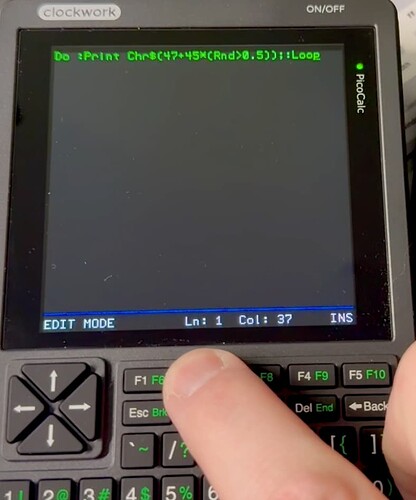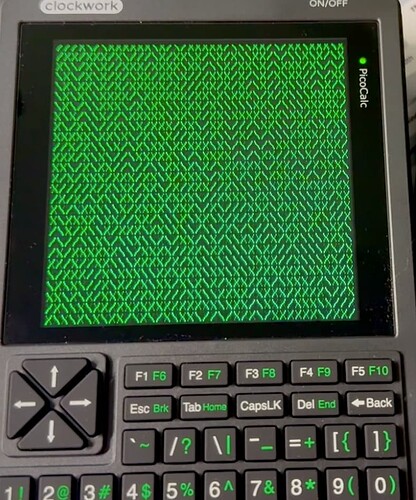Probably not but will do for the initial learning curve. Hence my hope someone will get a Pico2 or Pimoroni Pico Plus 2 working fully in this wee beastie. Shame Clockwork didn’t cater for more expansion, touch screen, ram, internal connectors for sensors etc. There is certainly the space..
Ordered when and delivered to which country ?
Ordered March 12, delivered to US today
a version of 10PRINT seemed in order as a first test
gonna need to hook up an external keyboard or edit programs over serial (if I can figure out what option to set for that) for longer programs. They keys are nice, but not for long typing sessions.
Just found your github and got this installed. You should definitely post this as its own thread.
That’s a very good point, and something I missed. So MMBasic could function as a sort of logic layer and provide the user interface for more elaborate stuff that might require better performance or access to things that aren’t directly available in MMBasic. That’s on Linux – doesn’t seem like the PicoCalc would offer that, which makes sense since there’s no OS to call into to run system commands. ![]()
Definitely seems good for GPIO stuff. Wireless seems like a good start with the WEB stuff, but BLE seems like it’s heavily used in IoT projects so with that missing I’d kind of disagree, at least for now. But that’s the sort of thing that can be added by the community if and when people see a need for it. I think part of the problem so far might be the fact that even Pico devices are largely considered “wired” and plugged into a power source, so it’s being treated more like a traditional full-sized Pi. And as far as hardware goes, the portable devices so far that use Pico have largely been handheld retro gaming devices. The PicoCalc might help change that view a little, since it makes the Pico portable as well, and it’s not really a gaming-focused device. Granted, plenty of people have built their own hobby projects with batteries and thumb keyboards (even repurposed Blackberry ones), but since there hasn’t been a more widely available “platform” for this, it makes sense no one has really been building software with that in mind.
Cool! One thing I haven’t pieced together yet is whether the Pico can natively support USB host via its USB-C or if it needs something additional connected. I’m guessing it’s the latter, and that’s why the Lyra is doing what they do.
How are your first impressions?
I’m wondering, since they’re not metal like the uconsole, how solid does the plastic feel?
the front is great, the back feels a bit cheap…
I wonder if they’ll make the case dimensions available too, if not I might try to design a 3D printed replacement.
Although they are both made of plastic, the quality is much better than DevTerm. In terms of size, it is a little smaller than uConsole and is more suitable for two-handed operation.

